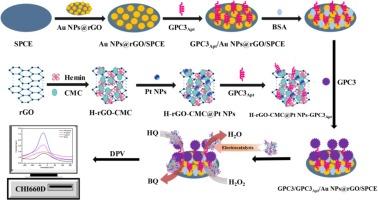基于 H-rGO-CMC@Pt NPs 和适配体的高灵敏度夹心型电化学传感器,用于检测 glypican-3
IF 4.9
2区 化学
Q1 CHEMISTRY, ANALYTICAL
引用次数: 0
摘要
Glypican-3(GPC3)是一种表面硫酸肝素蛋白多糖,已被广泛认为是诊断和治疗肝细胞癌(HCC)的理想生物标志物。准确而灵敏地检测血清 GPC3 水平是一项重要而具有挑战性的任务。本文设计了一种夹心电化学适配体传感器,通过适配体-目标-适配体的识别来特异性检测血清 GPC3 水平。GPC3 aptamer(GPC3Apt)被固定在金纳米粒子@还原氧化石墨烯修饰的丝网印刷电极(Au NPs@rGO/SPCE)表面作为捕获探针。血红素还原氧化石墨烯-羧甲基壳聚糖@铂纳米粒子(H-rGO-CMC@Pt NPs)具有良好的模拟过氧化物酶活性,其上标记了氨基化 GPC3 合酶,作为信号探针。目标 GPC3 被锚定在 GPC3Apt/Au NPs@rGO/SPCE 表面后,H-rGO-CMC@Pt NPs-GPC3Apt 进一步与 GPC3 特异性结合,形成aptamer-目标-aptamer 的三明治结构,从而催化对苯二酚(HQ)氧化成苯醌(BQ),并导致 DPV 记录的 HQ 氧化电流发生变化。HQ 氧化电流信号与 GPC3 浓度的线性关系范围分别为 0.0001-3.0 µg/mL 和 3.0-60.0 µg/mL,低检测限为 0.0685 ng/mL。此外,该电化学适配传感器还成功用于检测人血清样品中的 GPC3,回收率为 99.95-104.06%,相对标准偏差(RSD)为 1.31-5.22%。因此,夹心式灵敏传感器可为血清 GPC3 水平的检测提供一种新策略,并提高 HCC 的早期诊断率。本文章由计算机程序翻译,如有差异,请以英文原文为准。

A highly sensitive sandwich-type electrochemical sensor for detection glypican-3 based on H-rGO-CMC@Pt NPs and aptamers
Glypican-3 (GPC3), which is a surface heparan sulfate proteoglycan, has been widely known the ideal biomarker for diagnosis and treatment of hepatocellular carcinoma (HCC). Accurate and sensitive detection of serum GPC3 level is an important and challenging task. In this paper, a sandwich electrochemical aptasensor was designed to specifically detect serum GPC3 level through aptamer-target-aptamer recognition. A GPC3 aptamer (GPC3Apt) immobilized on the surface of gold nanoparticles@reduced graphene oxide modified screen-printed electrode (Au NPs@rGO/SPCE) was used as the capture probe. Hemin-reduced graphene oxide-carboxymethyl chitosan@platinum nanoparticles (H-rGO-CMC@Pt NPs), with good mimicking peroxidases activity, were labeled with amination GPC3 aptamer, which was employed as the signal probe. Once the target GPC3 was anchored on the surface of GPC3Apt/Au NPs@rGO/SPCE, the H-rGO-CMC@Pt NPs-GPC3Apt was further specifically bound to the GPC3, forming the aptamer-target-aptamer sandwich structure, which can catalyze the oxidation of hydroquinone (HQ) to benzoquinone (BQ) and lead the oxidation current of HQ recorded by DPV to changing. The linear relationship between the current signal of oxidation of HQ and GPC3 concentration range of 0.0001–3.0 µg/mL and 3.0–60.0 µg/mL, with a low detection limit (LOD) of 0.0685 ng/mL. Additionally, the electrochemical aptasensor was successfully applied for the detection of GPC3 in human serum samples with the recovery of 99.95–104.06 % and relative standard deviation (RSD) of 1.31–5.22 %. Thus, the sandwich aptasensor could provide a new strategy for detection of serum GPC3 level and improve the early diagnosis rate of HCC.
求助全文
通过发布文献求助,成功后即可免费获取论文全文。
去求助
来源期刊

Microchemical Journal
化学-分析化学
CiteScore
8.70
自引率
8.30%
发文量
1131
审稿时长
1.9 months
期刊介绍:
The Microchemical Journal is a peer reviewed journal devoted to all aspects and phases of analytical chemistry and chemical analysis. The Microchemical Journal publishes articles which are at the forefront of modern analytical chemistry and cover innovations in the techniques to the finest possible limits. This includes fundamental aspects, instrumentation, new developments, innovative and novel methods and applications including environmental and clinical field.
Traditional classical analytical methods such as spectrophotometry and titrimetry as well as established instrumentation methods such as flame and graphite furnace atomic absorption spectrometry, gas chromatography, and modified glassy or carbon electrode electrochemical methods will be considered, provided they show significant improvements and novelty compared to the established methods.
 求助内容:
求助内容: 应助结果提醒方式:
应助结果提醒方式:


